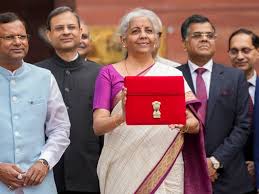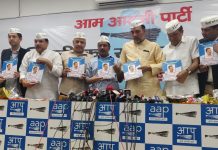
The opposition has flayed the government for splurging on the states governed by BJP’s key allies while ignoring those governed by INDIA bloc parties. It also rejected the government’s claim that the Budget has addressed the issues of unemployment and inflation. A report by CA-Sumiti Gaba
On July 23, 2024, India’s Finance Minister Nirmala Sitharaman unveiled the first Union Budget of the Modi 3.0 government, with a clear emphasis on the pivotal areas of our economy being employment, skilling, MSMEs, and the middle class. However, it failed to impress the opposition parties as the LoP Lok Sabha, Rahul Gandhi criticized the Union Budget, condemning it as inadequate and lacking in meaningful solutions to critical issues.
The government announced a package of five schemes and initiatives aimed at creating employment, enhancing skills, and providing other opportunities for 41 million youths over the next five years, with a central allocation of Rs 2 lakh crore. Moreover, a provision of INR 1.48 lakh crore has been made for enhancing education, creating employment opportunities, and advancing skilling programs.
The Budget influences a variety of sectors across the economy, impacting everything from infrastructure and healthcare to education and industry. By allocating funds and setting policy priorities, the Budget shapes economic growth, affects public services, and determines the level of support for different industries. This includes directing resources towards improving infrastructure, enhancing healthcare systems, funding educational initiatives, and providing assistance to micro, small and medium enterprises. Additionally, the Budget addresses social welfare programs, aiming to reduce poverty and inequality, and establishes fiscal policies that impact tax rates and government spending. Overall, the Budget plays a crucial role in steering the direction of national economic and social development.
The Leader of the Opposition Rahul Gandhi criticized the Union Budget. He argued that the budget failed to address key concerns such as high unemployment and inflation effectively. Gandhi also accused the government of neglecting the challenges faced by states not governed by the ruling NDA and criticized the budget’s overall approach. Meanwhile, the ruling party sees the budget as a strategic initiative that effectively supports key areas of economic development and social welfare, positioning it as a key tool for driving national progress.
The sectoral analysis has been detailed in the following sections, providing a comprehensive overview of how the Budget affects various areas of the economy.
The government’s budget emphasizes infrastructure development to support India’s goal of becoming a $40 trillion economy and transitioning from a developing to a developed nation by 2047. Key initiatives include allocation of Rs 11,11,111 crores for capital expenditure, representing 3.4% of GDP with the establishment of a Rs1000 crore venture capital fund for the space economy, allocation of Rs11,500 crores for flood control structures in Nepal to mitigate floods affecting Bihar. The other initiative is the introduction of the PM Surya Muft Bijli Ghar Yojana, which aims to install rooftop solar plants for 1 crore households, providing free electricity up to 300 units per month, with Rs 1 trillion allocated for this initiative. All these measures are expected to boost employment, industrial growth, and progress toward Net Zero Emissions by 2070.
Finance Minister Nirmala Sitharaman’s Budget 2024 outlines a major upgrade for the agriculture sector. Key initiatives being allocation of Rs 1.52 lakh crore for agriculture and allied sectors, and Rs 2.66 lakh crore for rural development and infrastructure, Phase IV of the Pradhan Mantri Gram Sadak Yojana (PMGSY) to provide all-weather connectivity to 25,000 rural habitations besides other measures, expected to increase crop transport by 8% land-related reforms to improve administration and planning, incentivized for completion within 3 years and construction of 3 crore houses under the Pradhan Mantri AwasYojana, boosting the real estate and allied sectors. The other ingenuities maybe, Pradhan Mantri Janjatiya Unnat Gram Abhiyan to improve socio-economic conditions for 5 crore people in 63,000 tribal villages, with promotion of natural farming among 1 crore farmers along with development of a strategy for self-sufficiency in pulses and oilseeds and creation of large-scale vegetable production clusters to improve supply chains and fair pricing and national cooperation policy to foster cooperative sector growth, accelerating rural economic and employment growth.
The government has outlined several strategies to enhance the manufacturing and service sectors, the growth steps can be taken by launching a comprehensive Internship scheme in top companies to increase employment opportunities, developing investment-ready “plug and play” industrial parks in or near 100 cities, with full infrastructure, in partnership with states and the private sector.
The budget also underscores the importance of the financial and banking sector in driving economic growth and safeguarding assets. With strategies of collateral-free loans for purchasing capital equipment up to Rs 100 crore, followed by in-house credit capability assessment by public sector banks, providing credit to MSMEs during stress periods to prevent NPAs and reducing the turnover threshold to Rs 250 crore. Additionally, Rs 1.5 lakh crore is allocated for long-term interest-free loans to support state infrastructure projects. The Mudra loan limit is increased from Rs 10 lakh to Rs 20 lakh for successful “Tarun” category entrepreneurs. However, the budget also proposes higher securities transaction tax (STT) on derivatives trading and increased capital gains taxes, potentially discouraging long-term
To enhance its global healthcare security ranking, the government has earmarked Rs 89,287 crore for the development of the healthcare system and Rs 2,143 crore for the PLI scheme for pharmaceuticals. Key measures include exempting customs duty on three cancer drugs and proposing changes to customs duties on medical X-ray equipment, operationalizing the Anusandhan National Research Fund with a financing pool of Rs1 lakh crore for research and innovation, increasing the allocation for biotechnology research and development from Rs 500 crore to Rs 1,100 crore.
The budget’s education & skill development initiatives aim to significantly impact India’s sector. Key measures include, education Loans providing provision of loans up to Rs10 lakh with a 3% annual interest subvention for students not qualifying for existing schemes, enhancing accessibility and affordability of higher education. Internship programs facilitated by top companies, these programs focus on unemployed youth aged 21-24, bridging the gap between academia and employment.
The Opposition has criticized the Budget as a political strategy intended to appease the BJP’s key allies, Janata Dal (United) and Telugu Desam Party, while neglecting urgent issues such as high unemployment and inflation. They argue that states governed by non-NDA parties have been overlooked. Former Finance Minister P. Chidambaram echoed these concerns, by criticizing the budget’s measures. He expressed scepticism about the government’s commitment to addressing inflation and noted that wages have remained stagnant over the past six years.
The BJP, on the other hand, has hailed the Budget 2024, praising its focus on economic growth through significant investments in infrastructure, education, and skill development and highlighting the strategic allocation of funds to impactful sectors like infrastructure and technology.













